by Aoife Donnellan // July 19, 2024
This article is part of our feature topic Desire.
In Virginia Woolf’s essay ‘Rambling Round Evelyn’ (1920), she explains that a “good diarist writes either for himself alone or for a posterity so distant that it can safely hear every secret and justly weigh every motive.” As their formats have evolved with the advancement of technology, from the locked notebook to online blogs and videos, so too has the intention of diaries. What was once a personal history addressed to future generations is now made instantly publicly accessible. The group exhibition ‘Digital Diaries’ at Julia Stoschek Foundation in Düsseldorf examines the friction between documentation and confession, as well as the feminist reclamation of the traditionally “masculine” lens. The digital and video works on view speak both alone, for themselves, and with a view to sharing these intimate thoughts with an audience. The works in ‘Digital Diaries’ are preoccupied with depicting various forms of desire—intimate relationships, the desire to be known and the limits of desire all find their voice in the different diary formats on view.
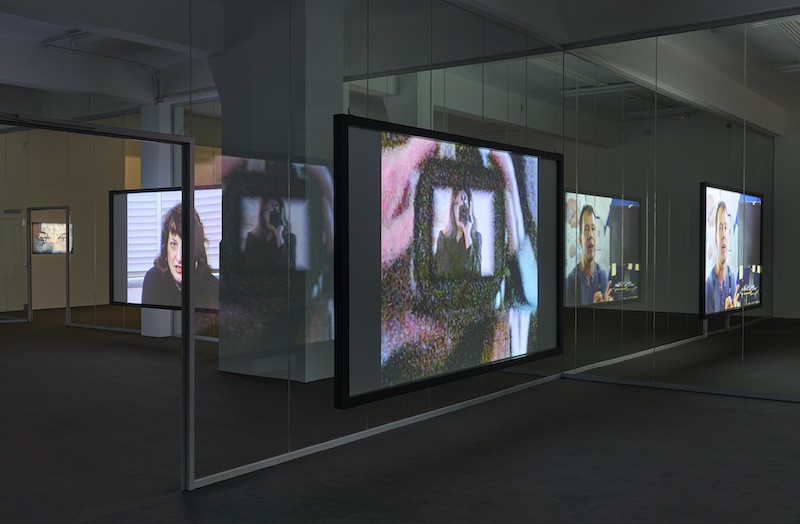
Lynn Hershman Leeson: ‘The Electronic Diaries of Lynn Hershman Leeson 1984–2019,’ 1984–2019, six-channel video installation, 74′, color, sound, installation view, ‘Lynn Hershman Leeson: Are Our Eyes Targets?,’ JSF Düsseldorf // Photo by Alwin Lay
‘Digital Diaries’ takes its inspiration from the exhibition on the floor above it, ‘Are Our Eyes Targets?’ by Lynn Hershman Leeson. The centre of the exhibition is ‘The Electronic Diaries of Lynn Hershman Leeson 1984–2019,’ which shows video diary entries from Hershman Leeson spanning three decades, wherein she speaks about her experiences and processes traumatic events in her life. Hershman Leeson’s diaries also trace the history of technology; large, grey desktop computers with floppy disk ports sit in the background of some entries, and handheld microphones in others. Beginning a year before Donna Haraway’s ‘A Cyborg Manifesto’ was published, Hershman Leeson’s ‘Electronic Diaries’ nevertheless considered a similar possibility, noting in one diary entry that she saw “a cyborgian future” for humanity. The video series is accompanied by a photography collage series, ‘Phantom Limbs’ (1985-1987), which depicts women’s bodies with televisions, cameras and binoculars for heads. This dissolution between personhood and technology highlights the primary consideration of Hershman Leeson’s work, which is to lay bare the intricacies of navigating self-expression through technology.
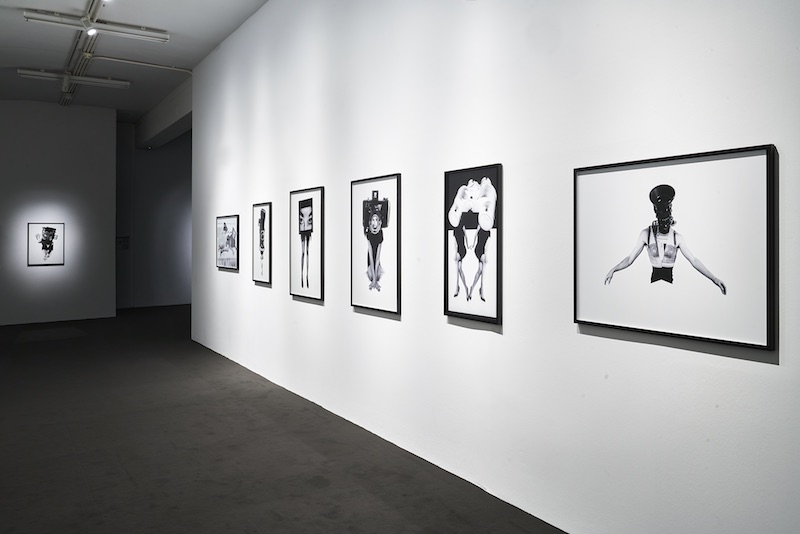
Lynn Hershman Leeson: ‘Are Our Eyes Targets?,’ installation view, JSF Düsseldorf // Photo by Alwin Lay
Downstairs, ‘Digital Diaries,’ curated by Line Ajan, features a range of works by 14 artists, including Sarah Lucas, Hannah Wilke, Rindon Johnson and Frances Stark. Glass walls separate each room, giving an eerie reflective quality to the video works on display. Lights flash from one room to the next, compelling us to move through the space. While the collection of artists vary in time, place, practice and media, they converge on a shared theme: the experimental diaristic form of the works captures the thread of desire running through each of their lives.
The installation of Frances Stark’s work, ‘Nothing is enough’ (2012), has an almost religious tone, arranged like a chapel with 5 rows of solemn black benches facing a large white projection. Black text showing snippets from a conversation Stark had online on a dating website with an Italian architect appears onscreen. The architect’s messages appear in italics, accompanied by mournful and gentle improvised piano, played by another man she met online. They discuss a number of topics including their dating lives, the effect the internet has had on them and who she could sleep with. Entering this devotional atmosphere, the colourful chaos of the previous room disappears behind you. The work has an ironic humour to it: “haha” appears onscreen as the piano music scores the rhythm of their conversation. It crescendos when Stark reveals that she has a boyfriend, lending theatrical suspense to the whole interaction. This digital depiction of sexual desire captures the detached nature of online dating. In the piece, the invisible dynamics of flirting are recreated using the aesthetics of religious solemnity, to highlight the absurd qualities these conversations can have. The melodramatic staging and soundscape of ‘Nothing is enough’ shows the isolation that can accompany relationships online, and points to the often solipsistic quality of the diary form.
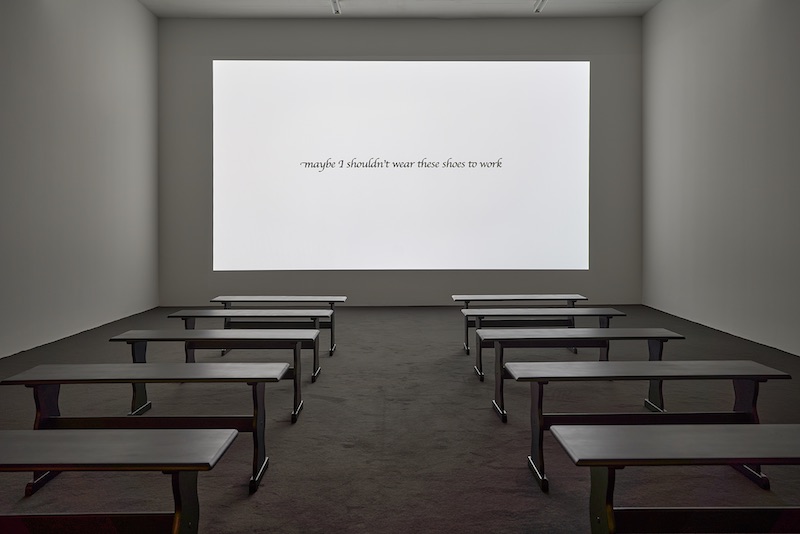
Frances Stark: ‘Nothing is enough,’ 2012, installation view, ‘Digital Diaries,’ JSF Düsseldorf // Photo by Alwin Lay
On a black fluorescent television in the corner of the next room is Sophie Calle’s ‘Double Blind’ (1992). This video piece follows Calle and her ex-partner, Greg Shephard, as they travel down the West Coast of the U.S. by car. Both of them film independent diaristic entries every day of their travels on hand-held cameras which, when blended together in a shot-reverse shot fashion, gives a more complex picture of their relationship. Calle’s entries usually begin with a view of the bed they slept in, accompanied by the statement “no sex last night.” The narrative is enthralling, as you’re taken into the confidence of a couple who seems to be at the end of their relationship. In one entry, Calle explains that Shephard has made an international call to “Kate” from their motel room, costing her $8, which is followed by a clip from Shephard where Calle tells him that the call cost $16. This collage of a disjointed shared reality is only evident with the interweaving of both sides of the tapes. Later in the work, Shephard explains that he feels trapped because he has no money to leave Calle, but that he has been overcharging her $2 each time he pays for petrol. Desire in this work is played out in a complicated and personal way, with Shephard admitting at one point: “I wish I was more in love with her.” Both participants are more honest with the imagined audience than one another, revealing the mistrust at the centre of their relationship, while they are also aware that they are creating work that will reveal a new truth. This documentation of the inner-landscapes of personal desire reminds the viewer that openness is key to intimacy. Calle and Shephard fail to engage one another meaningfully, instead acting as mere companions on separate journeys.
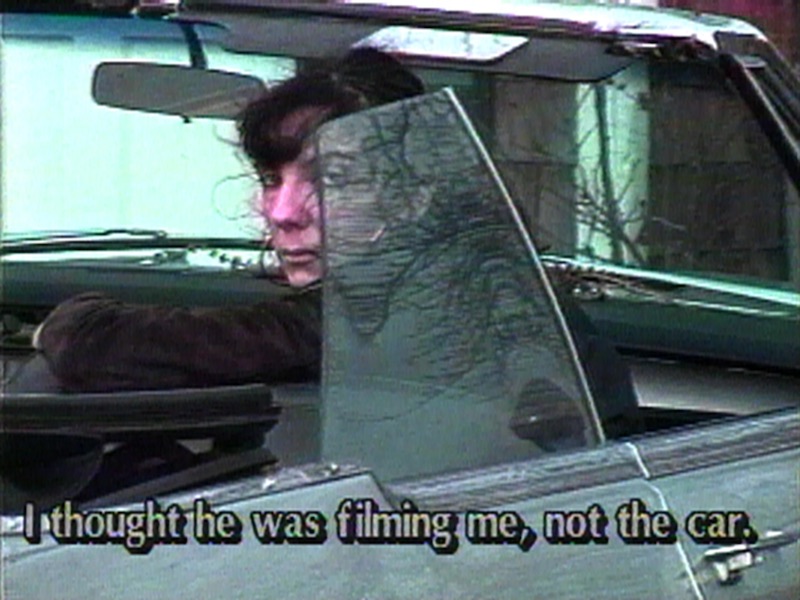
Sophie Calle: ‘Double Blind,’ 1992, video, 65′58″, color, sound, video still // Courtesy of the artist and Electronic Arts Intermix, New York
Beside Calle’s work sits Hannah Wilke’s ‘Intercourse with…’ (1977), depicting Wilke listening to her answering machine. The artist appears in a hat and coat, which she removes to reveal stickers of the names of the people who have left messages stuck to her chest. As the messages play, she removes the stickers of the messengers’ names from her body. Every message has an intimate, idiosyncratic quality, always differing in tone, cadence and content. The evolution of technology is foregrounded while listening to each person describe in detail their whereabouts, and why they have called. Hearing people enumerate their phone numbers, where they will be at 7pm and why Wilke should call them back, reminds us of the impossibility of returning to that reality, where people moved about without being reachable. Cryptic messages also featured, like “Good afternoon Hannah, this is your French lover”—which had a fantastically mysterious feeling when played over tape—while others revealed what were perhaps more quotidian facets of Wilke’s life, including her relationship with her agent, her dating life, her family and her friends. If diaries, as a method of representation, are a performance of self, then the performance in ‘Intercourse with…’ captures the low hum of desire as it features passively in a person’s life, woven between other appointments.
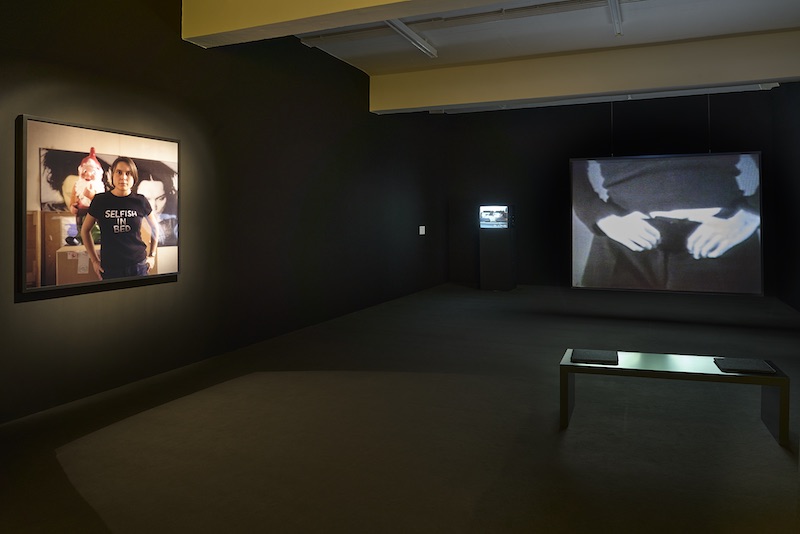
‘Digital Diaries,’ installation view, JSF Düsseldorf // Photo by Alwin Lay
A diary can be many things; a mirror, a time-capsule or, at the very least, in the words of Oscar Wilde, “something sensational to read on the train.” Diaries have had various functions throughout history, but on the most basic level they provide an insight into the intersection between a person and their surroundings. ‘Digital Diaries’ outlines the multiplicity of self-expression available with the proliferation of technology, underscoring the more intimate sides of documenting one’s environment. This inescapably personal medium is a testament to the persistence of the human need for self-reflection, and inevitably reveals desire as a fundamental element of all social interaction, allowing it to come and go.
Exhibition Info
Julia Stoschek Foundation
Group Show: ‘Digital Diaries’
Exhibition: Apr. 11, 2024–Feb. 2, 2025
Summer Party and Book Launch: Thursday, July 25; 6–10pm
jsfoundation.art
Schanzenstraße 54, 40549 Düsseldorf, click here for map






















